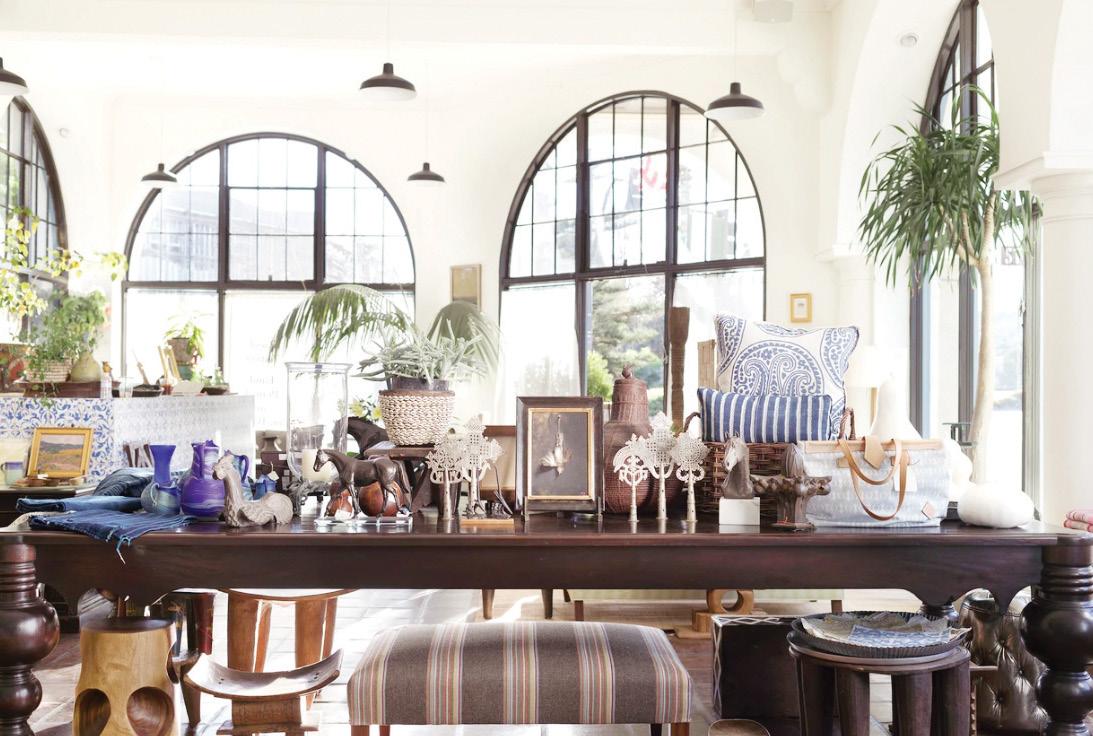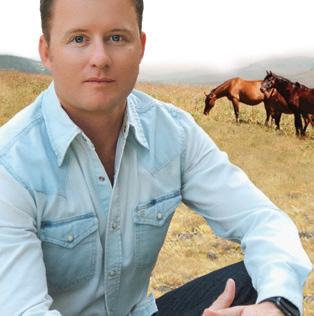
8 minute read
Pivot

The NEAT Method not only organizes your home and office, but can also help with moves and relocations – we’re talking packing and unpacking, too!
The Raoul Textiles store is located around the corner from their factory. “The store acts as the creative headquarters of Raoul’s.”
Though Raoul Textiles can be found across the nation and across the pond, this company is as Santa Barbaran as you can get. “Our family is from here, we all live and work here, and the store is our most personal reflection of our aesthetic and how we live in Santa Barbara,” designer and founder Sally design firm, which began in downtown SB in 1981, stands out because of the hand-pressed-in-Santa-Barbara
McQuillan said. The family-owned designs on luxurious Belgian linens and signature prints on fine fabric from Scotland, Belgium, and France. “We have a new collection of hand-printed linen pillows and one-of-a-kind accessories for the home,” Sally said. “Our clients are excited about brand new

colors of our hand-printed tea towels and lavender sachets.” (Side note: their remnants would make for some killer faces masks, too.)
Speaking of, they’ve adapted to the new normal through online sales. “We have just launched our e-commerce site. It is a reflection of some of our favorite things at the moment,” Sally said. “We are also lucky to represent many fantastic local artists, whose work enhances everything we do.” On raoultexti lesstore.com, you will find the signature textiles, antiques, art, and other curiosities like the Oaxacan Ropero basket or “splatterware” mixing bowls for your reinvigorated home cooking. With numerous features in House & Garden, Elle Decor, and even a mention in The New York Times, Raoul Textiles is the epitome of “think global, act local.”
Raoul Textiles 136 State Street, Santa Barbara (805) 899-4947 www.raoultextilesstore.com









NEAT Method So. The stay-at-home order gave you time to organize and clean out Designer Sally McQuillan (pictured) and her husband, Tim, started Raoul Textiles in Santa Barbara your home? Good for you! Oh, what’s in 1981 that? You stopped mid-way because all that stuff gave you more anxiety than the virus itself? Or, maybe you just thought about cleaning up but never got around to it? It’s ok, my friend. You are not alone, and Kat Pettey from the NEAT Method is here to help. The NEAT Method is an international company that specializes in home and office organization aiming to transform a space, “from chaotic to composed for an array of clientele.” Kat runs the Santa Barbara franchise, and services not only Montecito, but Carpinteria, Hope Ranch, Ojai, Santa Ynez, Summerland, and Ventura County. Not comfortable having someone in your home or prefer the DIY route? No problem. 34 MONTECITO JOURNAL “Man has his will, but woman has her way.” – Oliver Wendell Holmes Sr.
If the NEAT Method’s SB franchise owner Kat Pettey had to choose, kitchens are her favorite space to organize

Virtual organizing will be arranged where Kat will “provide a personalized shopping list and step-by-step instructions on how to make your space NEAT.” Besides home organizing, moving and relocation services are available too, including pre-move preparations, managing logistics, and creating customized solutions to get you off on the right foot. “NEAT Method Santa Barbara specializes in organizing, unpacking, and downsizing luxury homes and offices across Santa Barbara,” Kat says. “We make the space you have functional for the life you live.” If you’re sold on the Method, but afraid your family will mess up the newly organized space, accept that it will happen. Life goes on. But the good news is, with the NEAT Method already in place, a quick five- to ten-minute clean up will bring you back to a moment of Zen. Call Kat to book a consultation. •MJ
NEAT Method Kat Pettey (805) 705-1437 www.neatmethod.com/pages/san ta-barbara
Debating Desal’s Environmental Cost
Although officials are determined to continue operating the plant as long as possible and even hopefully triple its annual production, local environmental groups can be expected to make that as difficult as possible. Instead of safer (to sea life) subsurface intake and release pipes, the plant’s 1980s-era technology features open-intake water pipes which environmentalists say unnecessarily kill tiny ocean organisms.
“The city has had problem after problem with the intake system,” complained Kira Redmond, executive director of Santa Barbara Channelkeeper. “They tried to fix a 30-year-old plant that was just sitting there for all these years,” she added, referring to the fact that the plant shut down after just three months in 1991 and wasn’t brought back online until three years ago. “They need to replace the weir box on East Beach and move it back inland so it’s not so vulnerable to rising sea levels.” (A weir box is a water flow measuring device.)
Redmond and other activists are pressuring to force the city to apply for a new coastal development permit, arguing that the plant’s original permit only allowed it to be used to supply water during a drought emergency. They also want to force officials to complete a new Environmental Impact Report (EIR) focusing on whether the plant’s technology from 30 years ago is sufficiently advanced. “They need to do an EIR that looks at desal from the perspective of the modern day, as well as the energy impacts, and climate change impacts,” said Redmond. “We also need a more open public process where we look at all this moving forward.”
Despite all the debate about desal, the final draft of Santa Barbara’s 50-page term sheet outlining the details of its water supply agreement with Montecito explicitly specifies that it is only obligated to sell Montecito a certain amount of water each year for the next 50 years, and makes no particular promise that any much less every single ounce of that water will be created by its desalination plant. The legal Water, Beautiful Water? Montecito’s water may someday loophole might just sound like come from recycled wastewater. typical contract blather in case aliens blow up or steal Santa Barbara’s plant (in which case, water will no longer be our biggest problem).
But 50 years is a long time. It’s entirely possible that Santa Barbara will end up providing just part of the water it will owe Montecito from its desal plant, or perhaps none at all. It all depends on science, economics, and political will. While wave-motion energy based desalination still seems like a pie-in-the-sky notion, proposed innovations in water desalination technology such as reverse osmosis nanomembranes which might radically reduce the energy needed to desalinate water are entirely within the realm of reason. Remember, once upon a time, all efforts to make mass amounts of seawater drinkable by humans were considered pie-in-the-sky. So, you know, Science moves us forward and things can change.
Meanwhile, depending on political trends, Santa Barbara might eventually junk the plant and figure out how to recycle wastewater for landscaping. Or, someday even –cringe alert – we might have mass recycling of waste water into potable household water. “I am a big fan of recycled water,” said Redmond, noting that it has been successfully implemented by water agencies in Los Angeles, Orange County, and San Diego. “It’s also local and drought proof and is water that you will always have no matter what. And you are bettering the environment by dumping less treated sewage into the ground.”
Mass scale wastewater recycling, while still a remote possibility, isn’t something that even desal’s biggest proponent, Wicks, necessarily opposes. In fact, MWD to build a project that included recycling water back in 2015. “We made a proposal to the MWD to do just that,” he said. “We proposed a combined desal and recycled water project, the whole nine yards.”
According to Wicks, the recycled water idea went nowhere thanks to the competing egos and conflicting agendas that typify local water politics. “The important thing about this deal is that, for the first time, we will finally have a reliable local source of water,” he concluded. “No matter how much of it comes from desalination, it will be there and we will have it when we need it.” AHA! Update
Ever since the COVID-19 era unceremoniously ended the 2020 academic year in March, local educators and nonprofit groups have been redoubling their efforts to help young people deal with the added stress they’ve been experiencing. AHA!, whose mission is to reduce emotional and physical abuse on campus and has provided counseling to more than 20,000 teens and youth care providers since 1991, is no exception. Since May, AHA! has offered 11 online workshops attracting participants from around the world, offering guidance on everything from self-awareness and emotion management to relationship skills and responsible decision making.
In addition, the group’s summer session, which started on June 15 with morning and afternoon sessions featuring a combination of in-person (with social distancing) meetings and online sessions via Zoom. On June 30, from 10-11 am, Amber Phares, an associate marriage and counseling therapist, will hold a workshop focusing on the “gifts and challenges of self-care” during uncertain times, and on July 14 at 1-2 pm, Dr. Jennifer Freed and Melissa Lowenstein, M.Ed, will explore the challenges of parenting “in the midst of a pandemic and social justice revolution.”
Weekly workshops and teacher trainings will continue into the fall. Precontact Leonisa Caporal at leo.ahasb@gmail.com or visit www.ahasb.org. •MJ
Recycled Water, Anyone?
says Wicks, he and fellow board member Tobe Plough had initially tried to urge
registration is required at https://tinyurl.com/ahataller1. For more information












